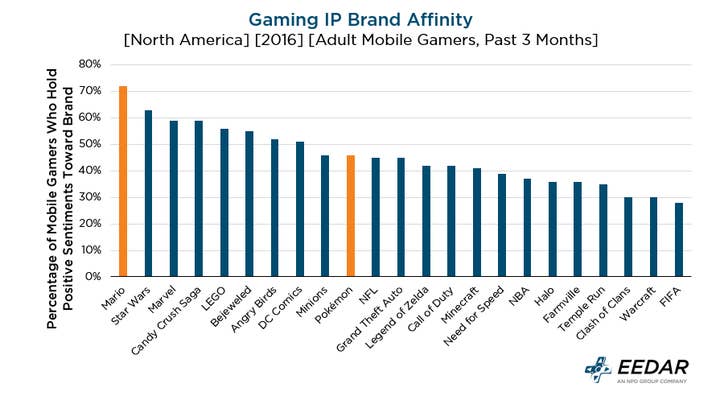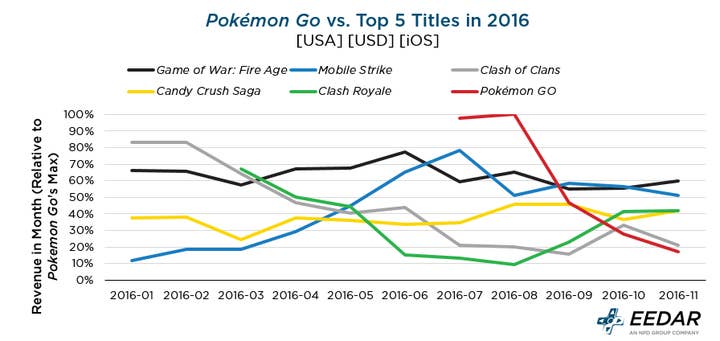Super Mario Run's missed opportunity
EEDAR details why a juggernaut brand is just the first step to breakout mobile success
Super Mario Run's December release has been polarizing. The game launched in over 150 countries and received over 10 million downloads on its first day, which is the highest download rate of any mobile game on day 1 by a significant margin. This number dwarfs Pokémon Go's 900 thousand downloads across three countries on its release day. Despite this extremely high rate of downloads, many investors and analysts are pessimistic about the game's chances for breakout financial success. While the powerful Nintendo brand is driving strong organic user acquisition, breakout mobile success requires strong monetization and retention as well.
Nintendo is a Super Powerful Brand among Mobile Gamers
Branding is as important in mobile gaming as ever. As the North American mobile market continues to mature, consumers have become more passive in their discovery of new games - currently, 39% of mobile gamers report that they are visiting an app storefront less than once a month and have not downloaded a game in over a month. Finding ways to help drive awareness for new titles outside of the App Store has become more important than ever, and featuring a powerful brand is one of the most effective means of achieving this goal.
Already in 2016, Pokémon Go clearly highlighted the power of branding to boost virality. Luckily for Nintendo, Super Mario Run contains one of the most popular gaming IPs in existence: Mario. EEDAR's analysis of the 2016 mobile market contains survey information from August 2016 (before Super Mario Run was announced) which shows that mobile gamers think very fondly of the Mario brand. In fact, it was the most positively viewed gaming-related brand surveyed.

Mario as a brand resonates very positively with mobile gamers. It holds a higher favorability rating than notable mobile brands such as Angry Birds and Candy Crush Saga, and it even rates higher than beloved transmedia brands such as Star Wars, Marvel, and Pokemon. Coupled with its immense brand power, Super Mario Run contains gameplay that stays true to Mario's 2D Platforming roots, with more accessible controls that are well-suited for a mobile experience. With a cooperative messaging push from Apple, it's no wonder Super Mario Run became a worldwide phenomenon at release. However, due to the game's pseudo-premium model, many in the industry are wary of its ability to generate revenue.
Super Mario Run's Free-to-Try Paid Business Model Presents Major Challenges to Monetization
Super Mario Run is a free download on the App Store, and players are able to play the first three levels for free. To unlock the rest of the game, players are asked to pay a single flat fee of $9.99, and there are no other monetization tactics present in the game. This is quite contrary to the traditional mobile standard of Free-to-Play games, where players can either slowly grind and progress through a game's content for free or choose to pay and speed up their progression.
The challenges of the premium business model in mobile are well-documented. In terms of generating revenue, there has not yet been a massive breakout success for premium games on mobile, and over 90% of iOS mobile game revenue is generated by free games. App Annie's early results show Super Mario Run generating $14 million in revenue in its first three days of release, and Nintendo confirmed that the game was downloaded over 40 million times. This places the game's conversion rate at 3.5%. Pokémon Go, the largest breakout success of 2016, generated revenues of over $600 million in its first 90 days. Even if conversion rate increased to 10% (an unheard of conversion rate for mobile), Super Mario Run will need to be downloaded on 600 million devices to reach that revenue number.
"Nintendo's strategy is still first and foremost to bring consumers into their hardware business"
Being a Mobile Market Leader Requires Strong Monetization and Retention
Super Mario Run is likely to have a sharp decline in revenue in the coming months due to its lack of ongoing monetization methods. In market-leading mobile games such as Game of War: Fire Age, players can spend thousands of dollars on in-app purchases over the course of many months. Kabam has stated that they measure retention in years rather than months because long term retention is so important to their model. In contrast, the most money Super Mario Run will ever make from any single player is $9.99. A Nintendo spokesman has stated that the company does not have any plans for future game updates.
The short term success of Pokémon Go, another title driven by a popular Nintendo brand, emphasizes the importance of retention for a mobile game. After record downloads and initial monthly revenue, the lack of significant updates and meaningful metagame opportunities have resulted in dwindling interest for the game. The top 5 titles in 2016, which feature very strong competitive metagame content, have held fairly consistent revenue earnings each month while Pokémon Go has been declining since September (The one exception being Clash of Clans, whose cannibalization challenges have been written about by EEDAR). The graph below, which utilizes EEDAR's mobile revenue database based on daily chart positioning, visually illustrates this decline:

Pokémon Go's metagame primarily focuses on joining one of the three Teams and leveling up Pokémon to take over territories. This is done by battling gyms which contain AI controlled Pokémon placed by the trainer(s) who took over the gym previously. While this appears to demonstrate proper metagame foundation, the execution has been lackluster. Players do not significantly interact with other Team members, and taking over gyms serves no broader purpose than a small individual reward. Outside of battling AI at gyms, there is no way to interact with other players via trading or trainer battles, two hallmarks of the Pokémon franchise. Coupled with the ongoing issues with the in-game Pokémon tracker, Pokémon GO has seen significant retention issues.
However, for Nintendo, It May Be All for the Switch
Despite the argument that Nintendo is leaving money on the table with Super Mario Run, the game should provide a strong boost to affinity and awareness of Nintendo as a company. This is likely where Nintendo was looking to find the most value from Super Mario Run.
With the upcoming March 2017 release of the Nintendo Switch, this boost in visibility from Super Mario Run is arriving at the perfect time for Nintendo. Nintendo's strategy is still first and foremost to bring consumers into their hardware business. EEDAR's report on the 2016 mobile market found that over 52% of mobile gamers also actively play console games. Nintendo advertising their key brands to these mobile gamers is a great way to generate interest in Nintendo's own new and existing hardware.

The recent success of Pokémon Go has shown the gains Nintendo can make on their own hardware when their most notable IP is utilized on mobile platforms. After Pokémon Go's successful release on mobile, Nintendo stated in a quarterly report that Nintendo 3DS family hardware sales were up 19% from the previous year, and they attributed this growth to Pokémon Go's success. After Pokémon Sun and Moon were released in November 2016, NPD reported that the duo had become the largest Pokémon franchise release of all time.
If the rumors of a flagship Mario title being released on the Nintendo Switch at launch are true, Super Mario Run's successful attempt at turning millions of eyes toward Nintendo just before the Switch is released with a brand new Mario game may prove to be a key factor in the new console's early adoption rate.
EEDAR's latest Deconstructing Mobile report is now available for 2016, and it provides an overview of the North American mobile gaming market, from demographic breakdowns, market sizing, behaviors and motivations, to genre performance and trends, and more. For the free version of the report, go here or email Cooper Waddell at cwaddell@EEDAR.com. This article was a collaboration by several EEDAR analysts in addition to the author, including Mike Schramm, Heather Nofziger, and Sartori Bernbeck.